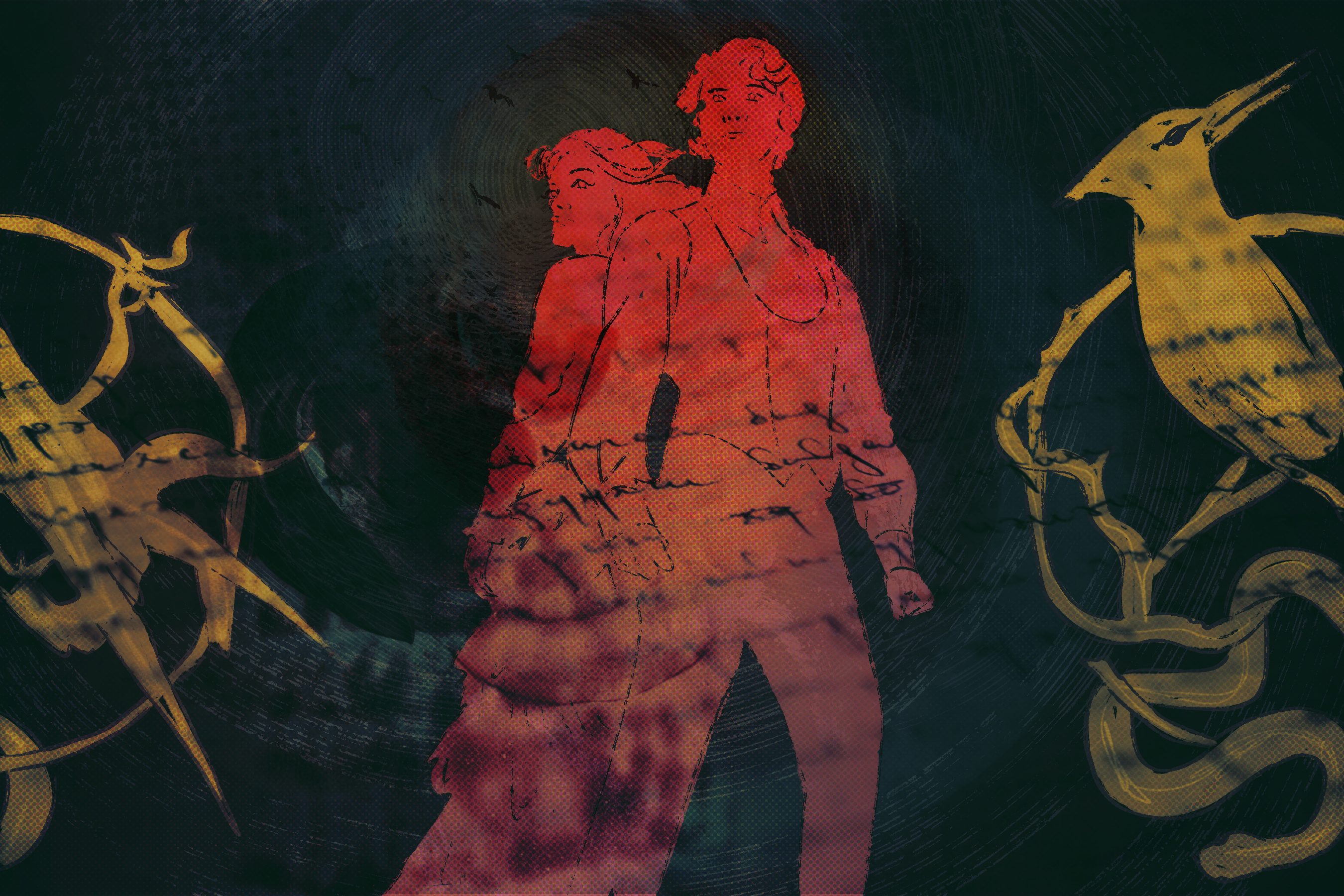As the silver screen flickered on and the lights began to dim, anticipation began to pull in the pit of my stomach. I am an avid lover of the book-to-screen Hunger Games franchise but was a little skeptical at how well the prequel, “A Ballad of Songbirds and Snakes,” would be pulled off. For the first few moments, I was drawn into this captivating dystopian world as soon as I heard a single word. Coriolanus. While this name may hold no weight to most, it set off a cascade of thoughts in my mind. This insight came mostly from taking a Shakespearean class on his tragedies. Nonetheless, the outpouring of ideas gave me a rather interesting view on this film that indicates this film could be a retelling of a much older story.
“A Ballad of Songbirds and Snakes” is a newly-released book-turned-movie set sixty years before the events of the first Hunger Games film.The story focuses on the main antagonist from the original Hunger Games series (Coriolanus Snow played by Tom Blyth), this time as the primary protagonist. The movie follows Snow’s mentorship to a District 12 tribute, Lucy Gray Baird played by Rachel Zegler. Lucy’s poignant charm and songbird-esque voice captivate all of Panem, often bringing many to tears.. The tributes selected from each district are meant to fight in the 10th annual Hunger Games, a sadistic game show that pits 24 children from the districts against each other in a battle to the death. Coriolanus, or Corio for short, helps Lucy win the games, but at a cost. He is sent away from his home, The Capitol, and forced to live a life of exile. The remainder of the story revolves around his relationship with Lucy and his journey back home.
As soon as I heard the name “Coriolanus,” I was instantly thrown back into my Shakespeare class. We had just finished learning about a play by the same name, which followed the rise and fall of Caius Martius Coriolanus, a tragic hero who saves Rome only to be exiled. His story ends tragically, as he leads an attack on Rome after his exile but ultimately changes his mind resulting in his death. This story is not exactly one of Shakespeare’s most popular plays for a number of reasons, but somehow this work stayed with me, setting off a wildfire in my brain when I heard the name Coriolanus uttered on screen.
Separated by roughly four hundred years, the two stories were not that different. Aside from the characters sharing a name, their stories share connections that become increasingly apparent – one that follows a man who achieves greatness in their flawed society. Yet both characters are exiled for their inability to navigate the political landscape.
Shakespeare’s Coriolanus, is demonstrated through his inability to work with politicians and his great disdain for plebians. Snow’s is for a lack of wealth, as well as his disapproval of the upper-class , and ultimately his love for Lucy Gray. These factors ultimately lead each to the aforementioned exile, causing them to fraternize with the enemy. Both attempt to return to their homeland and yet are eventually killed at the hands of the enemy whom they turned to. In Shakespeare’s Coriolanus’ fate, this occurs moments after trying to reconcile the Volsci and the Romans in which he is murdered by a long-time friend and rival. While Snow’s demise does not come until the final movie in the original Hunger Games Series, it does eventually occur in a similar fashion.
Snow is murdered due to the actions of a revolutionist named Katniss Everdeen who happens to be from the same district as Lucy Gray Baird. Katniss is most likely related to Lucy and is fairly reminiscent of her which makes Snow’s demise all the more potent, yet this does not occur until some sixty years later during the Movie “Mockingjay Part Two”. While these similarities in major plot points help show the connection between the two stories, it is the introduction of another vital figure that brings the stories into harmony. The most striking parallel between the two stories happens to come in the form of mother figures, who happen to share more than just the same name. These characters are Volumnia, mother of Coriolanus, and Dr. Volumnia Gaul, lead game maker in The Capitol. Each acts as the mother figures in both stories and have a hypnotizing influence on their respective Coriolanus.
Both are strong women in their own right, carefully playing puppet master and using all the tactics they have learned to achieve their ends. Shakespeare’s Volumnia does this by ensuring Coriolanus is raised to the highest position he possibly can, both on the battlefield and in peacetime. Dr. Gaul does this as well, by taking Snow under her wing, and then forcing him to experience dangerous situations (such as entering the arena) to strengthen her hold on him. Both play a role in shaping the character of their respective Coriolanus, but most strikingly both seem to rejoice in the wounds of their predecessors. Volumnia even goes so far as to state “O, he is wounded; I thank the gods for’t,” as her son comes home from battle scarred. Dr. Gaul’s equivalent of this comes when stitching the wounds of Snow, and noting his foray into death as he has just killed a tribute. She does not look at his actions with disdain, but later the viewer understands that this was planned to corrupt his mind. Both Volumnias are willing to put their protégé in harm’s way to strengthen them for their means.
Another similarity shared between both Coriolanus portrayals , is how they are viewed. Both women find themselves in a constrained position. Shakespeare’s Volumnia understands that she lives in a patriarchal society in which she cannot attain true power herself. Dr. Gaul is limited by her age and realizes that she will not live forever and must find someone to continue her legacy. Both use their Coriolanus to solve this problem.
Volumnia grooms Coriolanus to become the warrior he is, just as Dr. Volumnia coerces Snow to train under her and eventually become the head game maker. Both realize they cannot achieve the power they wish to in this life, and attach themselves to someone who can carry on. Both recognize that by making these characters extensions of themselves they can live on through them, potentially forever.
Now the plot and character similarities are very striking, but what brought this connection to another level for me was how “A Ballad of Songbirds and Snakes” was not just a retelling but added it’s own poignant twist to the classic tale. . While it is true both characters die in the end, Snow does not die until decades later and for the most part enjoys a full life. Shakespeare’s Coriolanus, on the other hand, is not granted this opportunity, as he was murdered soon after his call for peace. This key difference is what distinguishes both of these stories making each individually compelling. In the end, Shakespeare’s Coriolanus chooses to not embrace war which leads to his demise, despite retaining his honor and good-heartedness. As opposed to Snow who conversely chooses to embrace his dark side and align himself with the winning faction. Essentially, Snow gives into the yearning for power in exchange for his humanity, while Coriolanus exchanged his humanity for his life. This difference speaks volumes and brings both stories into a sort of dance complementing one another.
The two juxtaposing perspectives, while having the same ending many years later, achieved the same outcome after all. One provides a life of prosperity and the other a life six feet under. This makes “A Ballad of Songbirds and Snakes” more than just a retelling, but actually provides a different outcome reinforcing the original narrative.
Both “Coriolanus” and the “Ballad of Songbirds and Snakes” provide interesting insights into the themes of power, humanity, and the ideas of nature vs. nurture. While widely different in setting these two stories and the similarities found between them truly do allow for a comprehensive view of the human psyche. These similarities are found quite readily upon further inspection and allow for a strengthening of both stories. Both tell a story of power corruption and how demise is inevitable when set upon those paths. Each weaves compelling stories in flawed characters that allow audiences to understand. Both narratives provide deeper insights, and have helped me to contextualize and view “The Ballad of Songbird and Snakes” in a new light.
















